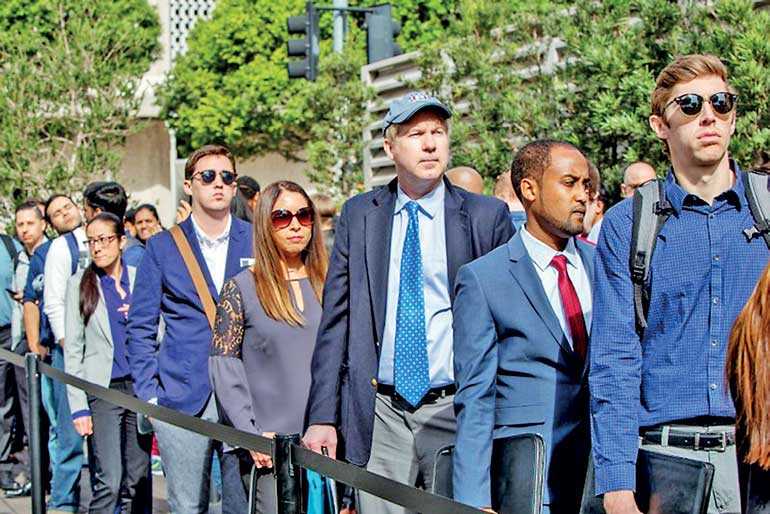Thursday Mar 06, 2025
Thursday Mar 06, 2025
Thursday, 10 May 2018 00:00 - - {{hitsCtrl.values.hits}}

WASHINGTON (Reuters): US job openings surged to a record high in March, suggesting that a recent slowdown in hiring was probably the result of employers having difficulties finding qualified workers.
The monthly Job Openings and Labor Turnover Survey, or JOLTS, released by the Labor Department on Tuesday also showed more workers voluntarily quit their jobs in March, a sign of confidence in the labour market that economists believe will help to push up wage growth this year.
The JOLTS report bolsters expectations that inflation will accelerate and keep the Federal Reserve on track to raise interest rates at least two more times this year. The US central bank hiked interest rates in March.
“The labour market is hot and getting hotter by the day so central bankers need to continue to take the punch bowl away because higher wages and greater inflation are on the way,” said Chris Rupkey, chief economist at MUFG in New York.
Job openings, a measure of labour demand, increased by 472,000 to a seasonally adjusted 6.6 million. March’s job openings were the highest since the data series started in December 2000.
Reuters Graphic
The job openings rate rose three-tenths of a percentage point to 4.2 percent, also an all-time high. But hiring fell to 5.4 million from 5.5 million in February, suggesting a skills mismatch. Job growth slowed in March and April after increasing by the most in more than 1-1/2 years in February.
The skills mismatch was also corroborated by an NFIB survey on Tuesday showing lack of qualified workers as “the single most important problem” for a fifth of small businesses in April.
“Businesses are looking for workers in just about every nook and cranny of the economy,” said Joel Naroff, chief economist at Naroff Economic Advisors in Holland, Pennsylvania.
Faster wage inflation seen
There were 112,000 additional vacancies in the professional and business services industries. The construction industry had 68,000 more job openings and companies in the transportation, warehousing, and utilities sector had 37,000 unfilled positions.
In March, job openings were concentrated in the Midwest and Northeast regions. There was 1.0 unemployed worker per job opening in March. The unemployment rate fell to a near 17-1/2-year low of 3.9 percent in April.
About 3.3 million Americans voluntarily quit their jobs in March, up from 3.2 million in February.
As a result, the quits rate, which policymakers and economists view as a measure of job market confidence, rose one-tenth of a percentage point to 2.3 percent. Quits accounted for a record 62 percent of separations in March. At the depths of the recession, they made up just a third.
“Quits are also a source of upward pressure on wages,” said Sarah House, a senior economist at Wells Fargo Securities in Charlotte, North Carolina. “The majority of workers who voluntarily change jobs receive a pay bump, generating stronger wage growth for job switchers.”
Wage growth as measured by average hourly earnings has remained moderate, increasing 2.6 percent year-on-year in April. But other gauges of wage growth have been more robust.
The Employment Cost Index, widely seen by policymakers and economists as one of the better measures of labor market slack, showed wages rising at their fastest pace in 11 years in the first quarter.
Layoffs fell 56,000 to 1.56 million in March.
Discover Kapruka, the leading online shopping platform in Sri Lanka, where you can conveniently send Gifts and Flowers to your loved ones for any event including Valentine ’s Day. Explore a wide range of popular Shopping Categories on Kapruka, including Toys, Groceries, Electronics, Birthday Cakes, Fruits, Chocolates, Flower Bouquets, Clothing, Watches, Lingerie, Gift Sets and Jewellery. Also if you’re interested in selling with Kapruka, Partner Central by Kapruka is the best solution to start with. Moreover, through Kapruka Global Shop, you can also enjoy the convenience of purchasing products from renowned platforms like Amazon and eBay and have them delivered to Sri Lanka.
Discover Kapruka, the leading online shopping platform in Sri Lanka, where you can conveniently send Gifts and Flowers to your loved ones for any event including Valentine ’s Day. Explore a wide range of popular Shopping Categories on Kapruka, including Toys, Groceries, Electronics, Birthday Cakes, Fruits, Chocolates, Flower Bouquets, Clothing, Watches, Lingerie, Gift Sets and Jewellery. Also if you’re interested in selling with Kapruka, Partner Central by Kapruka is the best solution to start with. Moreover, through Kapruka Global Shop, you can also enjoy the convenience of purchasing products from renowned platforms like Amazon and eBay and have them delivered to Sri Lanka.